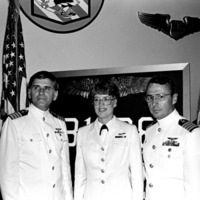Legacy
“Mary A. Crawford, the US Navy's first woman naval flight officer, at her June 1981 graduation.” Courtesy of the National Archives and Records Administration.
Although early aviatrixes broke both records and barriers during their time in the cockpit, it remained difficult for aspiring women pilots to get into the field after World War II. This was particularly true for women in the military. Despite the success of the WASP program, it wasn’t until 1976, more than thirty years after the end of WWII, that women could join the Air Force’s pilot training. Fighter pilot training would not open up to women until 1993. In 1974, Sally D. Woolfolk became the first female military pilot in the Army. That same year, Barbara Allen Rainey earned her wings, becoming the first woman pilot in the Navy.
Today, women make up about 19 percent of the Air Force and hold jobs in almost all fields of service. The number of female Air Force pilots, though, is still small. As of the end of 2014, women account for less than 700, or about 5 percent, of the approximately 13,000 Air Force pilots.
While women also hold a variety of jobs in the commercial flight industry, it is still a difficult field for female pilots to enter. Helen Richey became the first US woman commercial pilot in 1934, when she was hired by the now-defunct Central Airlines. Her career was short-lived. She was forced to resign ten months later by the all-male pilots’ union. Today, it’s estimated that there are around 4,000 women airline pilots worldwide—three percent of the total number of commercial pilots in the US and internationally.
Women’s pilot organizations, such as the Ninety-Nines (of which Amelia Earhart was a member and president) and the International Society for Women Airline Pilots, continue to advocate for the future of women in aviation.




